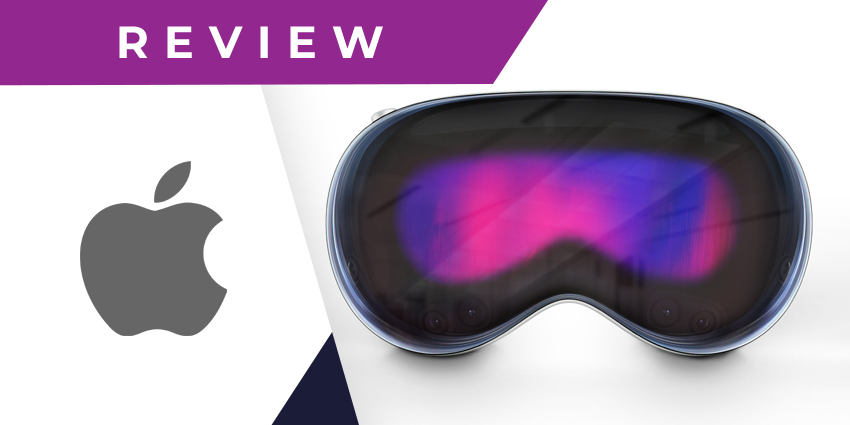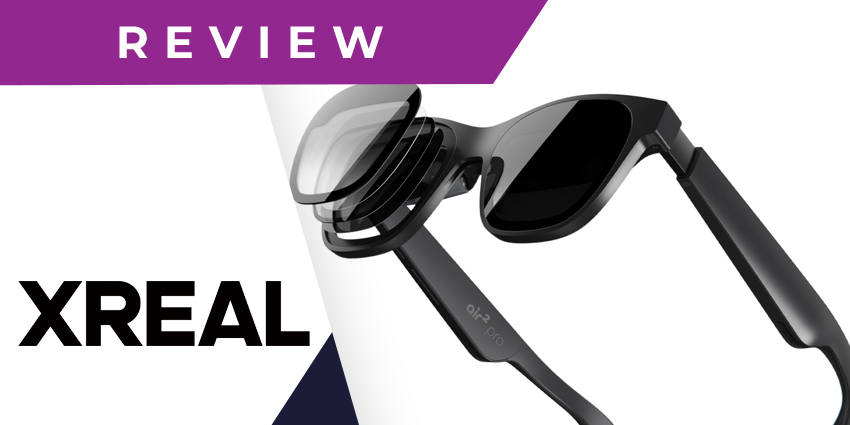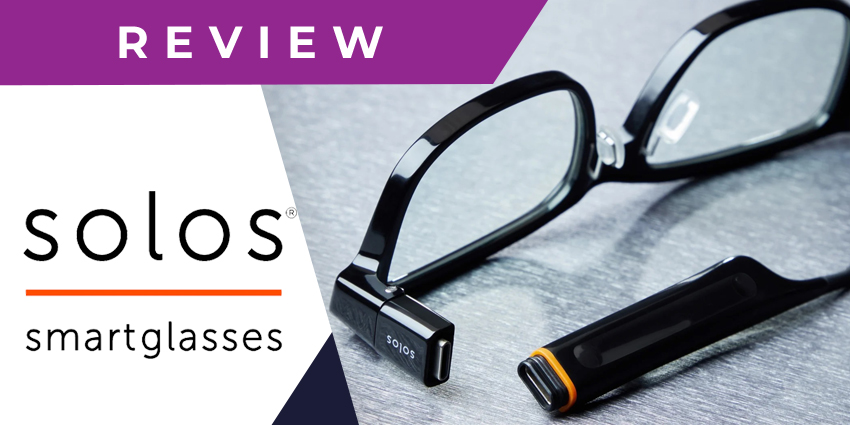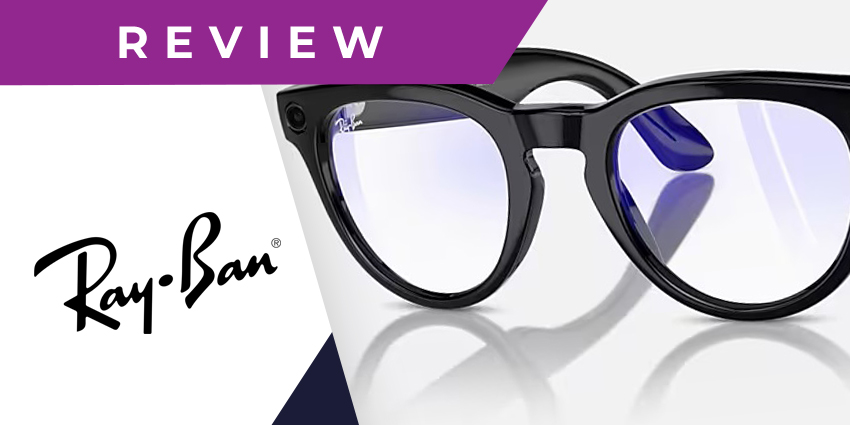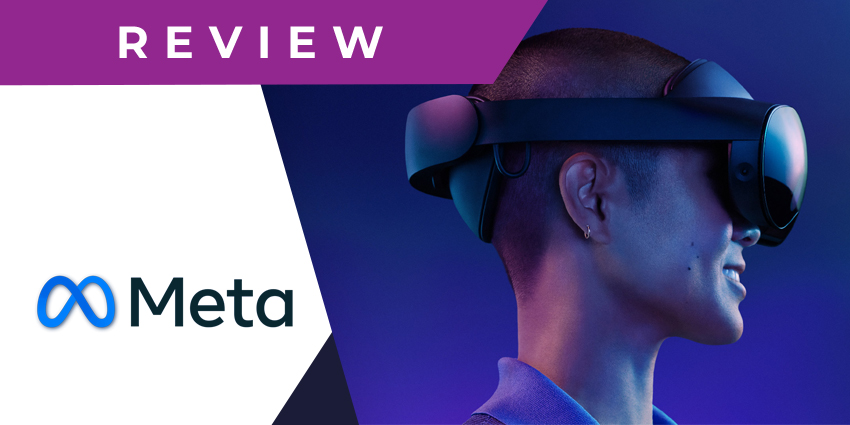In this Apple Vision Pro review, we’re finally taking a closer look at the spatial computing device set to change the extended reality world. We previously had an opportunity to check out this long-awaited XR headset in its demo version in 2023.
However, the Vision Pro is finally available to purchase, and countless consumers are starting to share their feedback (alongside a few memes). With a hefty price tag of around $3,500, the Vision Pro is under much pressure to revolutionize extended reality.
The question is, does it live up to expectations? Here’s everything we learned through our hands-on experiments with the device.
Apple Vision Pro Review: Quick Verdict, Pros and Cons
The Apple Vision Pro really is an XR headset, unlike anything we’ve seen before. Its futuristic eye, hand-tracking capabilities, incredible visuals, and breathtaking audio make it a true industry leader. We can see why it sold out so quickly.
However, like most XR devices, there are some “teething pains” to consider. The battery is a little problematic, and there are still early performance bugs to work out. Plus, the number of apps available for the Vision Pro is still relatively limited.
| Pros | Cons |
| · Phenomenal hand and eye tracking
· Truly impressive visual fidelity · Great spatial video and photos · Excellent ease of use for beginners · Exceptional comfort · Great communication features |
· Tethered battery detracts from the experience
· Missing certain big apps · Personas may need some work · Expensive pricing |
Apple Vision Pro Review: The Specs
Let’s start our Apple Vision Pro review with a closer look at the specs. After announcing the arrival of its XR device, Apple took a long time actually to confirm what the solution would do. Fortunately, we now know the specs do differentiate the headset from its competitors.
| Capacity | 256GB, 512GB, 1TB |
| Display | 23 million pixels, Micro-OLED, 7.5-micron pixel pitch, 3D display system, and 92% DCI-P3 |
| Refresh rates | 90Hz, 96Hz, and 100Hz |
| Video mirroring | 720p Airplay for mirroring your view |
| Chips | 8-core CPU with four performance cores, 10-core GPU, 16-core Neural engine, and 16GB unified memory (M2)
12-millisecond latency, 256GB memory bandwidth (R1) |
| Camera | Stereoscopic 3D main camera and spatial photo and video capture |
| Sensors | Two high-res main cameras, six world-tracking cameras, and four eye-tracking cameras. Plus, flicker and ambient light sensors. |
| Optic ID | Iris-based biometric authentication |
| OS | VisionOS |
| Audio | Spatial audio with dynamic head tracking, a 6-mic array with directional beamforming |
| Battery | 2 hours of general use or 2.5 hours of video |
| Connectivity | Bluetooth 5.3 and Wi-Fi 6 |
| Input | Hands, eyes, voice, keyboards, trackpads, and game controllers |
| IPD | 51-75mm |
| Weight | 21.2-22.9 ounces (based on headband) |
Apple Vision Pro Pricing and Availability
The Apple Vision Pro started rolling out for US customers on the 2nd of February, 2024. Elsewhere in the world, however, you may need to wait a little longer. Compared to other XR headsets, the Vision Pro is one of the most expensive we’ve seen.
So, how much does the Apple Vision Pro cost?
Prices start at $3,499 for the 256GB version, $3,699 for the 512GB version, and $3,899 for 1TB. Unfortunately, there may be other costs to consider, too. For instance, if you need Apple Vision Pro accessories, like a set of ZEISS optical inserts, those cost $99-$149.
If you want to protect your investment with Apple Care+, you’ll need to spend another $499 for two years of protection with unlimited repairs. Plus, there are also all the carrying cases and other “bonus” items you might want to buy for your new kit to consider, too.
Apple Vision Pro Review: Design and Comfort
While conducting this Apple Vision Pro review, we compared our feelings about the device’s design, comfort, and weight to feedback from other consumers. After all, different people experience headset comfort in different ways. For us, the Apple Vision Pro is one of the sleekest headsets we’ve tried.
It’s a world apart in aesthetic appeal from most of the XR headsets you’ll see on the market, with its unique curved glass panel and modular design structure. Plus, you get the benefit of a headset tailored to you. When buying a Pro, you’ll be asked to submit a face scan so the team can customize your light seal for your measurements.
This adds to the comfort, as does the option to choose between two headbands. The Solo Knit band is excellent for quick and easy access to your Vision Pro, with an adjustable fit. On the other hand, the Dual Loop Band offers more stability with an extra strap on the top of your head. We recommend using the second one for longer sessions.
However, whichever strap you choose, expect to feel a decent amount of weight. This headset weighs a little more than options like the Meta Quest 3, and you can feel the heft weighing down on your cheeks over time.
On the plus side, we do like the modular design of the Pro, which allows you to swap between Light Seal and Light Seal cushions in a couple of seconds. This makes it easy to customize your experience for different types of “immersive sessions.” Speaking of immersion, you also get the handy digital crown, which lets you dial the immersion up and down to suit your needs.
Visual Fidelity, Audio, and Performance
The visual experience on the Apple Vision Pro is genuinely phenomenal. The micro OLED 4K displays promise a combined clarity of 23 million pixels. This leads to an immersive experience, unlike anything you’ll get from most cheaper VR and AR headsets.
Even in pass-through mode, the visual fidelity is genuinely incredible. No matter your immersion level, you’ll see phenomenal visual contrast, vibrant colors, and rich details. It’s enough to cause countless other headsets to pale in comparison.
In terms of audio, you get a whole spatial audio experience that immerses you in any situation you can think of. Plus, the audio is personalized to you, with audio ray tracing capabilities. Apple’s headset supports various forms of audio playback, from AAC to Dolby Atmos. Plus, it has a six-mic array featuring directional beamforming for phenomenal communication.
The power of the built-in chips the Apple Vision Pro uses certainly does wonders for its performance. The M2 chip ensures consistent performance no matter what app you use. Plus, the R1 chip gives an extra boost to processing input from your camera, sensors, and microphones. That being said, there are some occasional bugs.
While interacting with the Pro is usually a relatively fluid experience, you might struggle to open apps or access Siri at certain times. This is likely just an initial teething problem for the headset, which should be addressed by further patches and software updates.
Interface, Hand, and Eye Tracking Capabilities
During our Apple Vision Pro review, we were impressed by how revolutionary the headset feels. It is more than just another AR/VR headset with phenomenal spatial computing capabilities. There are no controllers to master.
You can simply look at the element on the screen you want to interact with and tap your index finger and thumb together to “click” on something. While this new interface design might sound confusing, Apple walks you through the calibration process when you first start your headset.
It’s also worth noting that the VisionOS operating system starts with your real-world environment as a baseline. Apple wants to bring digital content into your environment rather than immersing you in a new world. The video passthrough is incredibly lifelike, so you’ll have no problem interacting with the natural world when using your Vision Pro.
Plus, the eye tracking is insanely good. Not only does it make it easier to interact with your apps and tools, but it also includes OpticID for authentication for your apps and purchases. In terms of hand tracking, you’ll have no problem scrolling between apps, zooming in on content, and playing games without worrying about too much lag.
Apple Vision Pro Review: Features for Work
One thing we were particularly keen to examine during our Apple Vision Pro review was the potential of the device for enterprise and business users. Apple is targeting more than just standard consumers with this high-quality headset. So, how does it improve your work experience?
First, it’s exceptional at multitasking, just like your standard office computer, thanks to the M2 chip that runs the OS. You can launch apps like Slack and Zoom while browsing the web on Safari just by talking to Siri. You can also move apps around your virtual space to create the perfect “desktop” experience for your specific needs.
While working, you can pull up the control center in seconds by looking up and clicking the downward-facing arrow. This allows you to change between “environments,” access Wi-Fi and Bluetooth, start screen recording, and more. The environments are similar to 3D desktops, immersing you in unique landscapes from the Moon to Yosemite.
Apple also offers specific environments for certain apps, like Apple TV+. The control center also gives you the option to connect with your Mac. However, you can also bring your desktop into the Vision Pro by looking at it. This will show a connect button above the device for quick and easy access to your desktop.
While there aren’t multiple desktop views, you get a phenomenal 4K display that perfectly renders text and images. Plus, you can use your keyboard and mouse normally without any latency. When communicating via text, you can type on a floating keyboard or use your standard keyboard. Plus, you can enter text with your voice by speaking to Siri.
The Apple Vision Pro Apps and Spatial Video
As mentioned above, the apps on the Apple Vision Pro are still a little limited, but that’s likely to change soon. So far, you can run thousands of compatible iPhone and iPad apps, though not all of these feature spatial and immersive capabilities.
Alongside Apple’s apps, you’ll also be able to experiment with a range of entertainment options (like Amazon Prime Video). There are social tools, like Reddit and Discord, and even productivity apps from Microsoft, Zoom, Webex, and Adobe to explore.
Some apps have yet to be released, and others are a work in progress, so it’s worth keeping an eye on the app marketplace as more developers get involved with the VisionOS ecosystem.
Another point worth noting is that the Apple Vision Pro supports spatial photos and videos you can take using your iPhone 15 Pro or iPhone 15 Pro Max. You can also capture videos to share with your team members or friends by clicking the top button on the left of the Pro headset.
The device does bring even static photos to life by wrapping them around you so you feel like you’re standing in the center of the frame.
Eyesight and Persona
Some of the most exciting features of the Apple Vision Pro, for both consumers, and hybrid workers, are Eyesight and Persona. These solutions were designed to ensure you don’t feel “disconnected” from the rest of the world when exploring the metaverse.
Eyesight allows people around you to see a digital rendition of your eyes on the outside of the headset when you’re using the Pro. It’s odd, but it’s still effective to maintain eye contact with your colleagues without taking off your headset.
Persona, still in beta, is a little more controversial. It adds to the “Facetime” experience for Vision Pro users by creating a 3D avatar you can use in calls. You’ll scan your face with the cameras on the Vision Pro, and the headset will build your Persona for you in a matter of seconds.
The result is pretty impressive, but it does feel a little “uncanny valley” for some users. The good news is if you don’t like how your Persona looks, you can constantly adjust the tone of your skin, add a filter, or make other changes yourself.
One feature we did like is that when you’re in a video call with your Persona, you can show your team your Vision Pro view and any apps you’re currently working on, making it excellent for collaborative work.
Apple Vision Pro Review: The Battery Life
Finally, we come to one major issue we discovered in our Apple Vision Pro review: the battery life. Unfortunately, all the power you get from the Vision Pro comes with a significant battery cost. If you can get past any feelings of VR sickness you might have and the headset’s weight, you can still only use the Vision Pro for about 2 hours at a time.
Notably, since the Vision Pro doesn’t have a built-in battery, you’ll need to constantly be connected to an external battery pack. This isn’t much of a problem for most users, but it can detract from the “immersive” experience when the wire constantly gets in the way.
It’s easy to accidentally pull on the cable when you’re amidst an immersive experience and send your battery rocketing out of your pocket. Fortunately, a few accessories, like a battery holder, can help reduce this problem (for an extra cost).
If you plan on using the Apple Vision Pro consistently, you can also plug the headset into an outlet with a USB-C power adapter. Unfortunately, this restricts how much you can move around in the Vision Pro.
Apple Vision Pro Review: The Verdict
It’s easy to ignore the potential of the Apple Vision Pro based on its huge price tag alone. Most consumers probably won’t be able to afford one of these headsets immediately, and businesses might struggle to offer a Vision Pro to all their team members.
However, after testing the Apple Vision Pro, we think it has something unique to offer the XR landscape. It could be the most innovative product Apple has released since the iPhone, marking a new era of immersive experiences.
Virtually every aspect of the headset is incredibly impressive, from the fantastic displays and video passthrough capabilities to the simple and convenient spatial interface. Even business opportunities are incredible, with fantastic collaboration features and apps for work already built in.
There are only a few potential problems, such as the annoying battery pack, the initial software bugs, and the lack of third-party immersive apps available at launch. However, many of these problems could be reduced or even eliminated by Apple over time.
Ultimately, we think the Apple Vision Pro is a revolutionary solution, worth the considerable price if you can afford such a significant investment. It’s an excellent insight into the potential that extended reality technology has to transform both our personal and professional lives.
